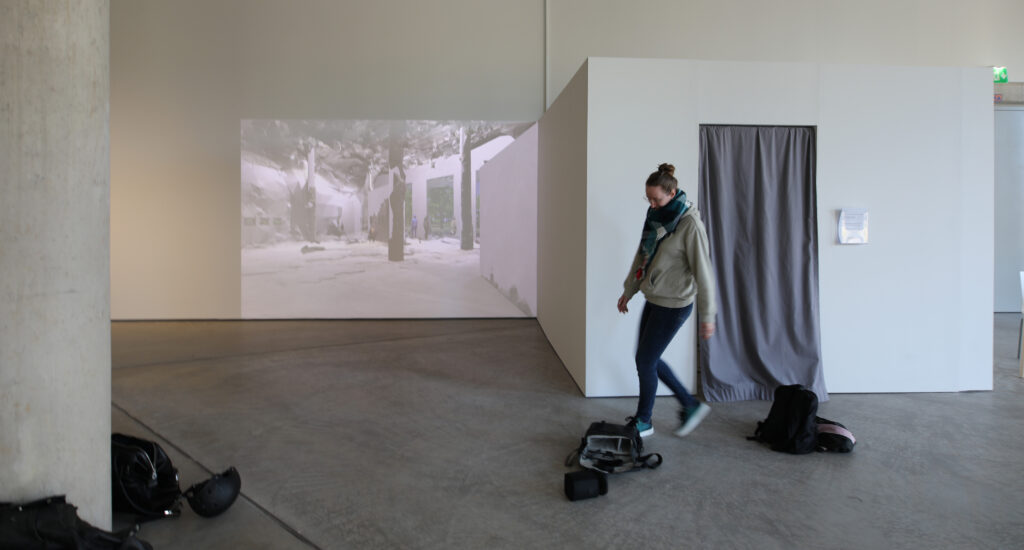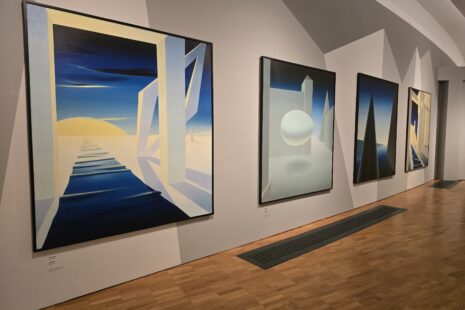Before the bachelor and master studies at the Academy of Fine Arts Helsinki in fine art, you had individual courses at Umeå University in philosophy, aesthetics, art history, art theory and drawing. How do the percentages of theory and practice divide in your creation?
The exact percentage is hard to estimate because of how I view the division between theory and practice within an artwork. Because of my interest and earlier studies, theory has developed to be a fundamental part of my artistic practice. This is still an important aspect of my education today and I’ve therefore chosen to attend many more thematic/theoretical courses than needed in my study plan. I see theory as kind of a seed in my works, which then grows and expresses itself through a chosen medium. In other words, my works usually start with a fundamental core linked to some theoretical or philosophical idea, which I then explore through practical work.
The material is therefore a way for me to deliver the theoretical aspect, which usually cannot be visible by itself. But due to the practical work being the dominant way of presenting artworks, it inevitably has a powerful voice in how the works are perceived, which then affects the balance between the two parts. This is why I try to let the practical aspects of the work have a symbiotic relationship with the theoretical in a way that lets both parts work together and strengthen each other. Therefore, I strive to give both parts enough room to work and grow equally between themselves so they can fulfill their individual tasks. The only exception would be if I notice that an imbalance between the two would somehow work in favor of the artwork itself. But this can of course be difficult to achieve.
There are many things in an artwork that can tip the scale in each direction, and every artwork I make will probably change my view on how successful I’ve been in the past with finding that balance due to my continuous artistic development.
You also have used quite a lot of technology in your artworks, i.e electroencephalography-based drawing machine etc etc. Would you call this kind on machinery your co-author or rather a tool like any other? Does a machine have a soul?
Long time before I started my studies at the academy, I didn’t really put so much thought into tools as a part of the artwork. If I did, it was more so about their individual aesthetic effect on the work itself, which of course is a big part of the resulting artwork. But besides taking the tools inherent ability to affect an artwork into consideration, I never really saw them as more than just tools. But by exploring my ideas in new ways, like with the help of technology, I would argue that these tools have revealed themselves to be something more than just tools in my works.
Therefore, working with experimental and unconventional methods has helped me realize that tools also have something to say through the finalized work as some sort of a secondary artist or a so-called co-author. This is even more apparent when talking about technology, which can be given even more freedom to impact and shape the work with some programming. So, the question if a machine has a soul is therefore tricky to answer, and I would say that it also depends on the definition of the word soul. But I do definitely recognize that tools, like the machines I’ve made and the technology I’ve used, have their own distinct presence that affects the outcome of the artworks similarly to the role of an artist.
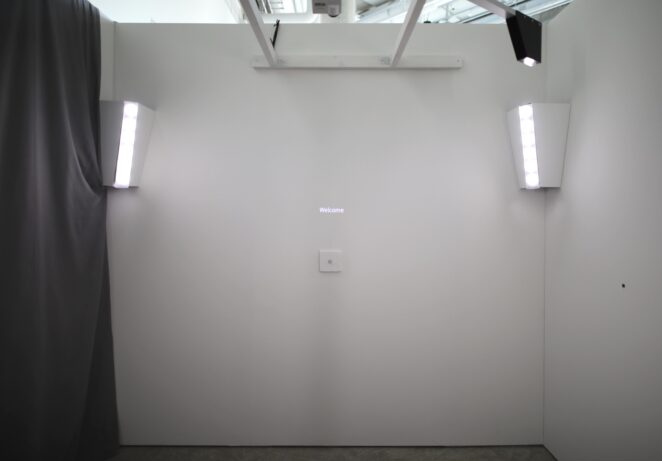
Scanner
In case of your NBYAA’21 winning work “Copies” the participants had to make a choice – whether to scan themselves and place their 3D scanned model inside of the gallery space amongst other models or just to observe them without scanning. How many visitors did the scanning and chose to actively step into the scene?
All in all, the exhibition had more than 2500 visitors in the span of four weeks time, and during the last day of the exhibition there were in total 121 models wandering around in the virtual gallery. Now this may not sound like a lot, but there’s a story behind these numbers.
So, in my earlier attempts at making participatory artworks, I’ve noticed that in general it is actually quite hard to get people engaged and participating in different works. Which is quite understandable and totally fine. With this experience in mind, I had mentally prepared myself that “Copies” would probably have only 1-3 participants per day – I even thought about the possibility that the virtual gallery might end up being completely empty. And because each scan takes some manual preparation for the 3D-models to be generated and appear in the virtual environment – approximately 40-60 minutes of work per model – , I thought it would be a reasonable amount of work for me to handle on my own.
I therefore installed this artwork in the gallery with the intention to keep the scanner open for everyone who wanted to be able to participate during the opening hours of the exhibition, and I planned to generate the scans as fast as possible during the days.
On the first couple of days of the exhibition there were about 40 people who participated by scanning themselves. This was of course way more than I had anticipated, so I took the decision to close the scanner for a week so I could get all the models done while also keeping up my studies full time at the academy. A week went by and even if I still had a queue of models to be generated, I chose to open up the scan again because my initial intention was indeed to keep it open during the whole exhibition. One day later I had 30 new scans on top of the existing queue and I closed the scan yet again.
In the end, I was only able to keep the scanner open for four days, which produced 121 models. So, each of the days the scanner was open, there were around 20 to 40 people who participated – ca. 3/10 of the visitors on those days participated. Meaning, if the scanner would have been open every day, according to these numbers there would have been potentially 750 scans lined up. Which is way too much to handle being only one person preparing each scan – 750 scans would have taken at least 500 hours to prepare.
In retrospect it is clear that I underestimated how many people wanted to participate, and I’m sad over the fact that I needed to close down the scan for such a big part of the exhibition which inevitably affected the outlook of the work. But regardless of that, I’m incredibly happy and I appreciate the enormous amount of interest and engagement people showed in “Copies”. For “Copies” next exhibit, I’ll try my best to get help with the work so it can be shown without closing the scanner.
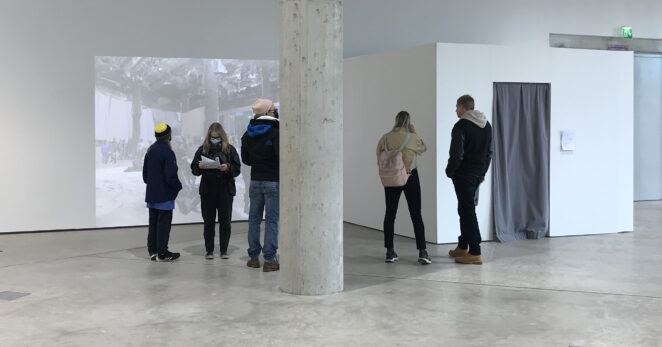
Visitors
This kind of choice is related to decision making – what has been the hardest decision in your own life? And which one is the easiest?
Many decisions are and have been hard because life is not easy. Things happen unexpectedly all the time and I’ve learned that the best way for me to keep on breathing through difficult situations is to learn some coping mechanisms and keep a close eye on my mental health. In that sense, challenging decisions have definitely been easier to deal with, and it’s therefore difficult to know which one of them was the worst. But one particularly tough decision to make was when it was time to let my dog pass away. The decision in itself was maybe not a hard one to take, because at some point you know what’s the right thing to do. But the hard part is to deal with the loss and the grief that follows after years of unconditional love for each other.
With the long history of my struggles to get accepted to a higher education of fine arts, one of the easiest decisions I have ever taken was to accept my spot at the Academy of Fine Arts in Helsinki. By that time I had unsuccessfully tried applying to various fine art academies six years in a row, so on my seventh attempt I decided to try applying to the Academy of Fine Arts in Helsinki as well. When I was accepted, it was a no-brainer for me to show up in Helsinki even though it is always tough to move away from friends and family.
The introduction text of “Copies” raised many other questions about identity to think about. But what kind of feelings would they evoke?
I think that one of the best things in “Copies” is that the feelings involved when observing the work is highly individual and the experience of it depends a lot on what kind of relationship you have with yourself. For this reason, it’s difficult to answer what others would feel when they see themselves, or others for that matter. But speaking for myself, I experienced a variety of emotions, from playful curiosity to intense anxiety, which surfaced at different stages while observing “Copies”.
So, in the beginning during initial testing of the work, my scan was all alone in the virtual gallery. At first I felt this playful curiosity towards my scan and I found it really humorous to watch the strange behavior “I” had in that virtual environment. But after a while I got used to the strangeness of the situation and the playful relationship died out when I never got any contact with my other version. She just wandered around and did her own thing, without ever acknowledging me staring at her. Normally, a person would probably notice and ask what’s up, but of course that never happened here.
For this reason, I suddenly felt that she was really vulnerable and that I was somehow very violent towards my copy. I mean, it was I who had taken the decision to put her in that empty space in the first place. I became even more uncomfortable when I realised that I was staring at her as if I were sitting in an audience while she was performing on a stage, which is an incredibly unnatural position for me to be in due to my lack of experience being in the spotlight.
This roller coaster of emotions was something I was intrigued by and I was happy about the fact that maybe I had been able to do an artwork which in some part had the possibility to bring all these layers of a relationship visible.
And the roller coaster didn’t stop there. Later, when “Copies” was up and running and slowly being filled with these beautiful unique 3D models, I felt relief and became more comfortable in the relationship with my own model when I knew that I/she wasn’t alone anymore. I also noticed that for every scan added, “Copies” changed a little bit and brought different sets of emotions into the limelight, which made it really interesting to observe all the 3D models together. This became especially apparent when some visitors took the chance to creatively interpret the instructions on how to make a scan, which resulted in all kinds of 3D models walking around the virtual gallery. For example a group of friends that went into the scan together, people posing in a specific way that didn’t match the set scanning pose or people making political statements through their appearance.
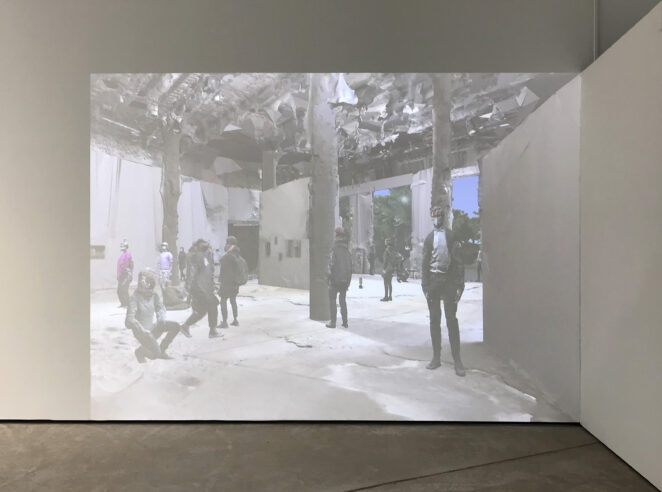
3D gallery
What happened to the “Copies” after the graduating show at Kuva/Tila gallery?
This specific version of the work will be saved as is with all the 3D models in it. I also hope that I will get the chance to install it again in +10 years in the future in the Kuva/Tila gallery and continue to explore the added layer of time it would create. I find it really intriguing to think about the possibility to see our past versions of ourselves wandering around the gallery, and explore the questions about time relative to us and the setting it is exhibited in. Maybe it would act a little bit like a mirror to the past.
Aside from that, I would love to exhibit the work “Copies” in other spaces at new locations to see how the work would continue to develop with new participants. Because I truly believe that “Copies” still have a lot to give and I’m curious to see how it evolves with time.
Tell us more about the gallery space, which are the conditions there, who are the typical visitors, which is its position in Helsinki’s and / or Finland’s art landscape?
Kuva/Tila (Picture/Space) gallery is a completely new gallery space located at the Academy of Fine Arts new building called Mylly (The Mill), which is connected to the same campus as the Theater Academy. The space is large and spectacular with its almost 8 meter high walls and nearly 750 square meters floor space to accommodate for example large scale works and installations. Academy of Fine Arts exhibitions introduces new emerging artists from the masters- and bachelor degree program and offers new perspectives on how to make and present contemporary art. With a full exhibition programme and its annual events, like the BFA degree show and MFA degree exhibition called “Kuvan Kevät” (Picture Spring), it continues to promote innovative art in the contemporary art scene.
Historically, the exhibitions are visited by various professionals from the art world, students and also by those who are generally interested in art and culture. But with this new building, the exhibitions will hopefully also be visited by an additional audience of occasional visitors and those who are interested in the space itself.
The bachelor’s exhibition, in which “Copies” were exhibited, was the first exhibition ever held in the new Kuva/Tila gallery. The exhibition was well received, and attended by more than 2,500 people in total.
Who are your own favorites from other participants of NBYAA’21 contest?
Oh, there were so many! I want to give credit to all the contestants for their beautifully done artworks and I’m proud of being a part of such a strong group of peers. I truly recommend checking out all the other participants that I don’t mention here, because my list is way too short to really show the broad spectrum of talented people in this contest.
But, here’s in no particular order a couple of fellow artists that opened up about their respective subject matter and gave me an opportunity to get a sneak peek into the wonderful world of art through the artist point of view: Riikka Anttonen, Dmitrijs Jefimenko, Henrihs Binans, Justīne Seile-Urtāne, Einari Hyvönen, Envija Vernere, Laura Liepina, Annabel Kajetski, Nicolina Stylianou, Verneri Salonen, Eliis Laul and Kristina Villand.
Finally, I want to take the opportunity to thank NBYAA and the jury for creating these opportunities for emerging artists, my teachers for their continuous support and help with my ambitious projects, Svenska kulturfonden for sponsoring “Copies”, and my family & friends for always being there for me. Thank you!

“Copies”

